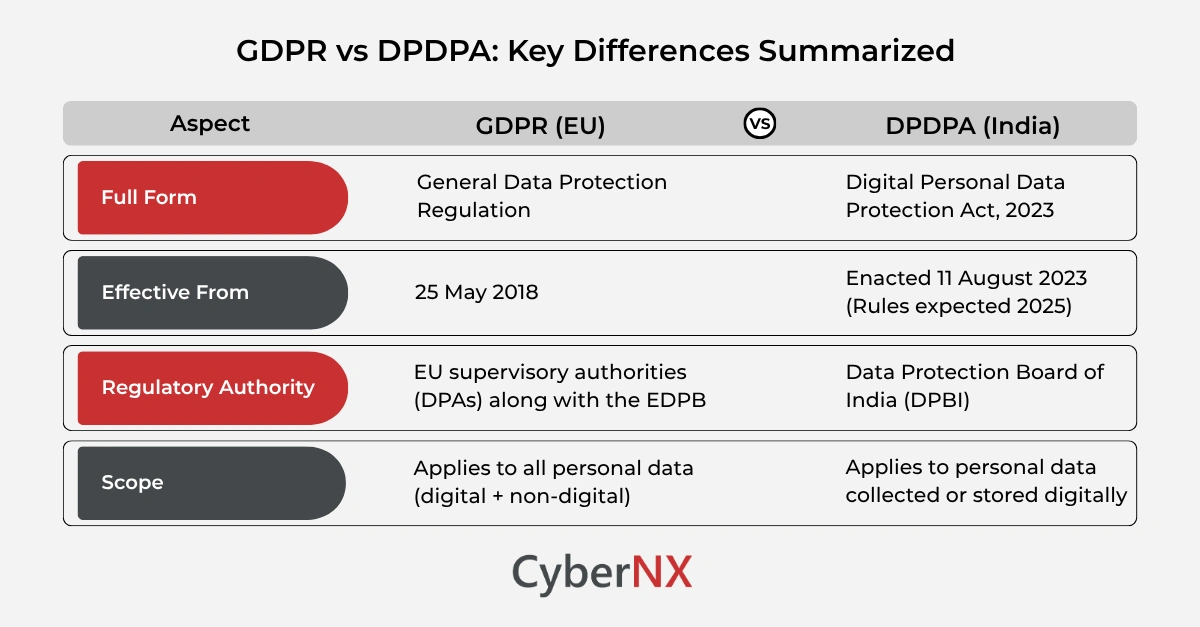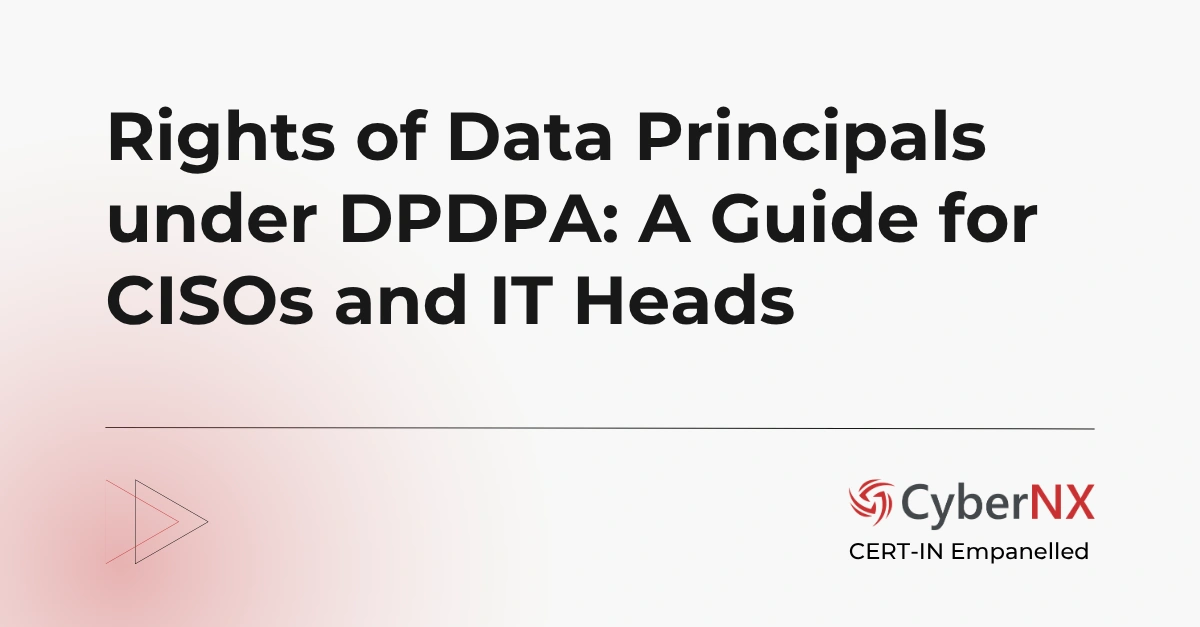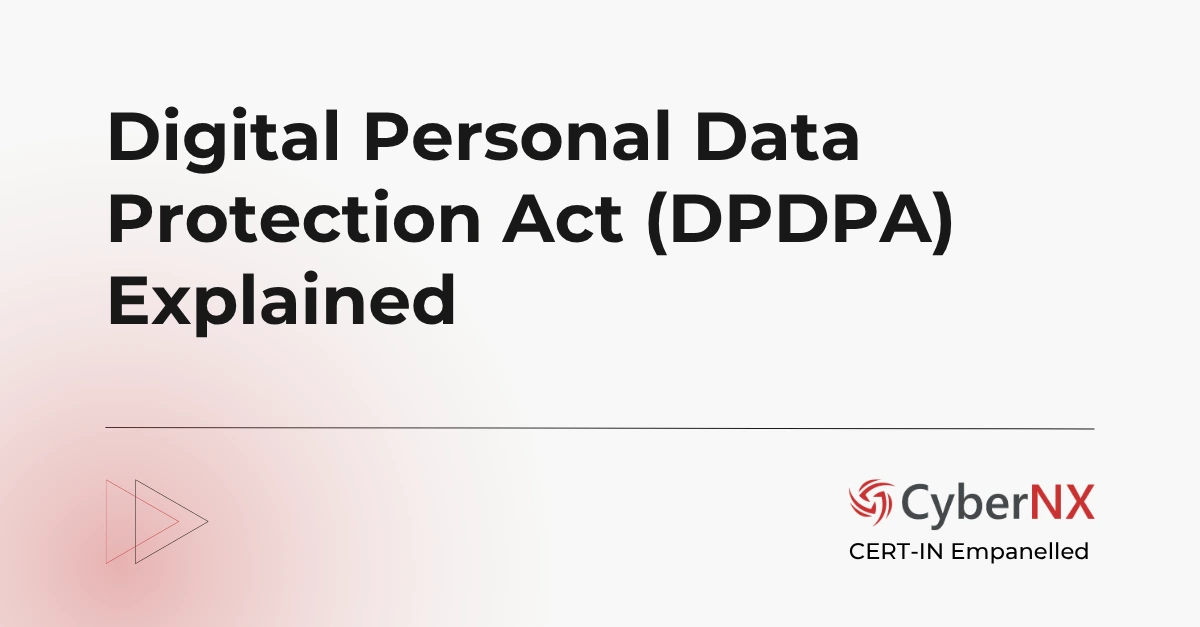The rapidly shifting regulatory environment is a mounting challenge for global organisations managing personal data. The GDPR has long stood as the benchmark for data-protection standards in Europe and beyond. Now India’s DPDPA is on the verge of being implemented.
For CISOs, IT Heads and cybersecurity leaders, understanding DPDPA vs GDPR dynamics is essential to drive compliant data-processing practices and manage risk across jurisdictions. This is especially true for companies operating in different geographies.
In this blog, we combine expertise and clarity to help you distil differences between the two regulations, identify implications and help you to act confidently.
What is DPDPA and what is GDPR?
Let’s first clearly understand these two regulations and what they stand for.
1. Digital Personal Data Protection Act (DPDPA)
The Digital Personal Data Protection Act, 2023 (DPDPA) is India’s federal law aimed at regulating the processing of digital personal data of individuals (data principals) by data fiduciaries and data processors.
It was enacted on August 11, 2023. The components include obligations on consent, rights of individuals, cross-border transfers, and the establishment of a Data Protection Board of India. The act is not fully in force at the time of writing this blog.
2. General Data Protection Regulation (GDPR)
The General Data Protection Regulation (GDPR) is the European Union’s comprehensive data protection law that came into force in May 2018. It applies to personal data of individuals within the EU, and to organisations outside the EU that process that data.
It defines key concepts like data controller, data processor, data subject rights, lawful bases for processing, and sets high standards for accountability, transparency and cross-border data transfers.
Why compare DPDPA vs GDPR?
Many companies operate across geographies. If you process EU citizen data and Indian citizen data, you face overlapping requirements. By comparing DPDPA vs GDPR you can:
- Assess where your policies align and where they diverge.
- Optimise compliance programmes so that dual-regime obligations are managed efficiently.
- Reduce legal and operational risk from misalignment.
- Demonstrate to leadership and boards that you understand cross-jurisdictional requirements.
Key similarities between DPDPA and GDPR
Before diving into differences, it’s helpful to recognise what both laws share.
- Both frameworks recognise individual rights to access, correction and erasure of personal data.
- Both impose obligations on those who process personal data: GDPR on controllers/processors and DPDPA on data fiduciaries/processors.
- Both establish cross-border data transfer rules, albeit with different parameters.
- Both emphasise consent as a valid legal basis for processing personal data.
These commonalities provide a foundation for organisations to build a compliance-framework that leverages overlapping requirements.
What is the difference between GDPR and Digital Personal Data Protection Act?
Here we focus on the main areas where DPDPA and GDPR diverge and what it means for enterprises.
1. Scope and coverage
GDPR covers “personal data” in both digital and non-digital formats (i.e., all forms of personal data). DPDPA applies to “digital personal data” – personal data collected in digital form, or subsequently digitised.
GDPR has extraterritorial effect: it applies where organisations process personal data of EU residents irrespective of organisation’s location. DPDPA also has extraterritorial reach but applies in digital data contexts and if goods/services are offered to individuals in India.
2. Legal bases for processing
GDPR provides multiple lawful bases: consent, contractual necessity, legitimate interests, legal obligation, vital interests, public interest.
DPDPA is more consent-centric and focuses on “consent or legitimate use” (which is narrower) rather than offering broad bases like legitimate interest.
3. Sensitive data / classification
Under GDPR there are “special categories of personal data” (sensitive data) that require higher protection. DPDPA currently does not define separate categories of sensitive personal data in the Act itself. It applies uniformly to all digital personal data, though subordinate rules may classify categories later.
4. Children’s data and specific obligations
GDPR has provisions for children’s consent and profiling, but DPDPA includes explicit rules for verifiable parental consent for children (< 18) and persons with disabilities. Also, DPDPA mandates specific safeguards for processing children’s data under its rules.
5. Cross-border data transfers
GDPR restricts transfers to countries without an “adequacy decision” unless appropriate safeguards are used. DPDPA permits cross-border transfers unless restricted by the Indian government or rules and lacks an adequacy-framework yet.
6. Enforcement, penalties and governance
GDPR empowers national Data Protection Authorities and the [European] Data Protection Board; fines can reach up to €20 million or 4 % of global turnover (whichever is higher) for serious infringements.
DPDPA provides for a Data Protection Board of India and penalties in India’s financial terms (e.g., up to INR 500 million etc) for breaches.
7. Technical/organisational obligations
GDPR mandates aspects such as Data Protection Impact Assessments (DPIAs), data-protection by design and default, appointment of Data Protection Officers (in certain cases).
DPDPA’s rules (Draft Rules 2025) also provide for DPIAs and security safeguards, but some aspects remain under rules/notification and thus may be less mature in practice.
| Aspect | GDPR (EU) | DPDPA (India) |
| Full Form | General Data Protection Regulation | Digital Personal Data Protection Act, 2023 |
| Effective From | 25 May 2018 | Enacted 11 August 2023 (Rules expected 2025) |
| Regulatory Authority | EU Data Protection Authorities (DPAs) + European Data Protection Board | Data Protection Board of India (DPBI) |
| Scope | Applies to all personal data (digital + non-digital) | Applies to digital personal data only (data collected or digitised) |
| Territorial Reach | Global – applies to any organisation processing EU citizen data | Global – applies to entities offering goods/services to individuals in India |
| Legal Bases for Processing | Consent, contract, legal obligation, vital interest, public task, legitimate interest | Consent + “legitimate use” (limited cases such as legal obligations or emergencies) |
| Definition of Sensitive Data | Special categories (health, race, religion, etc.) receive extra protection | No separate sensitive data category yet; applies uniformly to all digital data |
| Children’s Data | Parental consent required for children under 16 (can vary 13–16 per Member State) | Parental consent required for children under 18 and persons with disabilities |
| Data Subject Rights | Access, rectification, erasure, restriction, portability, objection | Access, correction, erasure, grievance redressal, consent withdrawal |
| Cross-Border Transfers | Allowed to countries with EU “adequacy” or via safeguards (SCCs, BCRs) | Allowed unless restricted by Indian government; no adequacy list yet |
| Data Protection Officer (DPO) | Mandatory for public authorities or large-scale sensitive processing | Required for “significant data fiduciaries” (criteria defined by government) |
| Breach Notification | Must notify regulator within 72 hours | Must inform Data Protection Board and affected users “as soon as possible” (exact timeline under rules) |
| Fines & Penalties | Up to €20 million or 4 % of global annual turnover | Up to ₹250 crore (≈ €27 million) depending on violation |
| Data Protection Impact Assessment (DPIA) | Mandatory for high-risk processing | Required for “significant data fiduciaries” (defined by rules) |
| Data Localisation | No strict localisation requirement (transfer governed by adequacy/safeguards) | No strict localisation; government may restrict transfers to specific countries |
| Legislative Intent | Strengthen privacy and data rights across the EU | Enable responsible digital growth while protecting citizens’ data rights |
| Status of Subordinate Rules | Fully operational | Draft Rules (expected 2025) to define operational procedures |
What this means for security and compliance teams
The regulations have practical implications for public and private enterprises operating in the regions we have discussed.
- Organisations operating in both EU and India need dual-compliance: Ensure that data-processing activities satisfy GDPR and DPDPA requirements.
- Review your processing-activity register: Ensure you have mapped digitisation, consent flows, territorial triggers (Indian vs EU).
- Consent-mechanism review: Since DPDPA emphasises consent, ensure your workflows capture “free, specific, informed, unconditional, unambiguous” consent (same language as DPDPA).
- Data-transfer architecture: For Indian operations, anticipate additional rules as the government notifies further. For EU operations, maintain adequacy or other safeguards.
- Governance model: While GDPR is well established, DPDPA is newer—so expect additional rulemaking and guidance. Ensure you monitor the subordinate rules (for example Draft Rules 2025).
- Non-compliance: Non-compliance with either regime exposes you to reputational risk, regulatory fines, operational disruption.
- Cross-jurisdictional privacy-roadmap: For global firms, consider aligning key controls rather than treat each law in isolation.
- Build a “privacy-first” architecture: By embedding robust controls now you can reduce friction when new jurisdictions (like India under DPDPA) come online.
Conclusion
The comparison of DPDPA and GDPR reveals overlap but also important divergences. GDPR remains more mature and comprehensive; DPDPA reflects India’s context, emphasising digital data and consent, with unique obligations and evolving rules.
It is necessary to map your data-processing landscape, evaluate how your current GDPR-based controls align with DPDPA, and build a pragmatic compliance roadmap that bridges both regimes. Every step you take strengthens your readiness and reduces legal exposure.
Ensure your business is DPDPA-ready. Connect with CyberNX for a tailored DPDPA consultation and take the first step toward full compliance. In addition, our certified privacy professionals will create harmonized approach aligning DPDPA with GDPR for comprehensive data protection programs.
DPDPA vs GDPR FAQs
Does DPDPA apply to non-digital (offline) personal data?
No. DPDPA applies to digital personal data or data collected non-digitally and later digitised. It does not currently cover purely offline data processing.
Can organisations rely on “legitimate interests” as a lawful basis under DPDPA?
Not exactly. Unlike GDPR, which allows legitimate interests as one basis, DPDPA focuses primarily on consent or legitimate use defined under the Act; so you should review your basis carefully.
When will DPDPA rules come into force?
While the Act is enacted (August 2023), the subordinate rules (e.g., Draft Rules 2025) and enforcement mechanisms are still being finalised. Organisations should prepare now for its full operationalisation.
If a company is already GDPR-compliant, does it automatically comply with DPDPA?
Not automatically. While many controls may overlap, DPDPA includes unique obligations (consent emphasis, digital-data scope, transfer rules) which require tailored review and possible enhancements.






